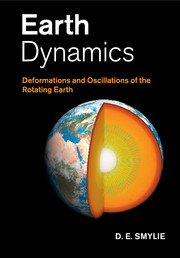Book contents
- Frontmatter
- Contents
- Preface and acknowledgments
- The book website www.cambridge.org/smylie
- 1 Introduction and theoretical background
- 2 Time sequence and spectral analysis
- 3 Earth deformations
- 4 Earth's rotation: observations and theory
- 5 Earth's figure and gravitation
- 6 Rotating fluids and the outer core
- 7 The subseismic equation and boundary conditions
- 8 Variational methods and core modes
- 9 Static deformations and dislocation theory
- Appendix A Elementary results from vector analysis
- Appendix B Properties of Legendre functions
- Appendix C Numerical Earth models
- References
- Fortran index
- Subject index
2 - Time sequence and spectral analysis
Published online by Cambridge University Press: 05 March 2013
- Frontmatter
- Contents
- Preface and acknowledgments
- The book website www.cambridge.org/smylie
- 1 Introduction and theoretical background
- 2 Time sequence and spectral analysis
- 3 Earth deformations
- 4 Earth's rotation: observations and theory
- 5 Earth's figure and gravitation
- 6 Rotating fluids and the outer core
- 7 The subseismic equation and boundary conditions
- 8 Variational methods and core modes
- 9 Static deformations and dislocation theory
- Appendix A Elementary results from vector analysis
- Appendix B Properties of Legendre functions
- Appendix C Numerical Earth models
- References
- Fortran index
- Subject index
Summary
New discoveries in Earth dynamics can only be made through the comparison of theory with observations. Often we are looking for signals close to or below the noise level; otherwise, they would have already been observed. Thus, the analysis of observations in both time and frequency domains is of crucial importance.
For several decades now, observations in the time domain have been represented by discrete samples. The samples may be equally spaced along the time axis or unequally spaced. Unequally spaced samples may result from inherent properties of the measurement technique, or from fundamental restrictions such as the visibility of sources at particular times. Unequally spaced samples may also be the result of digitiser failure or other instrument problems, leaving gaps in otherwise equally spaced time sequences. We include the analysis of unequally spaced time sequences and the application of singular value decomposition to their study. Most sequences of interest were originally continuous physical signals. Thus, we examine the effects of the sampling process itself on the results of the analysis.
Often observations are made at several locations and it is desired to bring out common features of the records from different observatories. For this purpose, we describe in detail, the product spectrum. This may be regarded as a kind of generalisation of the cross spectrum between two records. As is the case in any spectral analysis, the estimation of confidence intervals is of prime importance in establishing the significance of the results.
- Type
- Chapter
- Information
- Earth DynamicsDeformations and Oscillations of the Rotating Earth, pp. 93 - 211Publisher: Cambridge University PressPrint publication year: 2013



